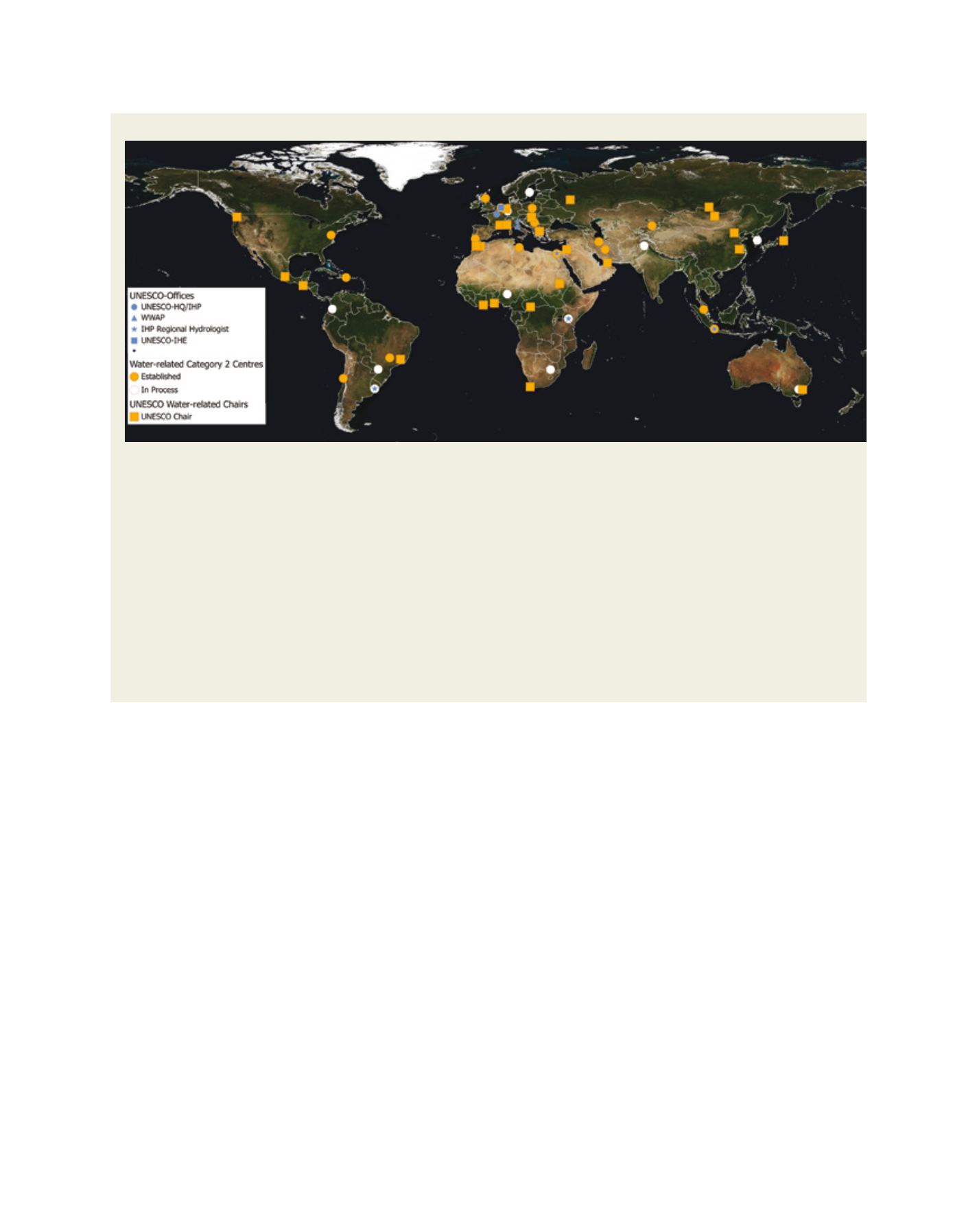

[
] 14
F
ree
F
low
(UN DESD); physical aspects of hydrology; training of media profes-
sionals on water issues; water-related cultural and natural heritage and
the cultural aspects of water.
In each axis, specific attention will be given to UNESCO’s global
priorities of Africa and gender equality, and to youth and small island
development states, South-South, North-South, North-North and
triangular cooperation at the regional and global levels. UNESCO
fosters existing partnerships with public and private partners and
builds strategic partnerships to successfully address the complex
challenges related to water security. UNESCO centres and chairs
play an important role in this process, and IHP currently pursues the
improvement of their geographical and thematic scope, also in the
light of UNESCO’s global priorities of Africa and gender equality.
Due to global changes, high demographic pressure and the lack
of effective governance and management of surface and groundwa-
ter resources, many regions in Africa are particularly vulnerable to
droughts and floods. It is crucial to continue supporting African
countries in the domain of water sciences and cooperation, because
developing the scientific understanding of hydrological processes
and phenomena constitutes a source of socioeconomic development
and regional and international solidarity. UNESCO gives special
attention to water, peace and security; building up resilience to
water-related disasters; capacity building; and the role that ground-
water resources play in rural areas for agriculture and in
urban areas for regional development, notably in water-
scarce areas and in the context of climate change.
Equality between women and men exists when both
genders are able to share equally in the distribution of
power and knowledge and have equal opportunities,
rights and obligations. Gender equality is an essential
component of human rights, and a key to development.
Yet, of the world’s 1 billion poorest people, three fifths
are women and girls. At the same time, women make up
only one quarter of the world’s researchers.
5
Access to freshwater resources directly influences
women’s lives. Women represent the majority of people
affected by unsafe water and sanitation; they are most
often the collectors, users and managers of water in
households and are heavily engaged in agricultural
activities for food production. Their responsibility in
using, providing and managing water for household and
livelihoods means that women play a crucial role in the
sustainable use and management of water resources.
UNESCO’s gender mainstreaming approach ensures
that women and men benefit equally from programme
and policy support. It aims at achieving all international
The UNESCO Water Family
Since its early focus on water, initiated in 1956, UNESCO has developed
a comprehensive water family, comprising IHP and its 168 National
Committees, UNESCO-IHE, the network of water-related centres under the
auspices of UNESCO, UNESCO Chairs and WWAP. These structures involve
a global workforce of approximately 1,000 water experts and graduate
researchers at the service of Member States. This UNESCO network
is regarded as the leading agency for freshwater sciences and policy,
governance, and management advice.
IHP is the intergovernmental cooperation programme on water sciences,
research, governance, management and education. It was created in 1975
as a follow-up to the International Hydrological Decade, and is governed by an
Intergovernmental Council and implemented by 168 IHP National Committees.
The UNESCO-IHE Institute for Water Education in Delft, the Netherlands,
formally became part of UNESCO in 2003. UNESCO-IHE is the largest
postgraduate water education facility in the world. It confers fully
accredited Masters degrees and promotes PhDs. It has enhanced the
capacities of 14,500 water professionals from over 160 countries.
WWAP, in Perugia, Italy, is a flagship programme of UN-Water, which
brings together 30 United Nations agencies. It is housed, administered
and led by UNESCO. Starting in 2014, WWAP will produce the periodic
World Water Development Reports on an annual basis and on specific
topics (such as water and energy), with a five-year global synthesis report.
The network of 18 established water-related centres under the auspices of
UNESCO (category 2 institutes and centres) contributes to the implementation
of IHP at the international and regional level. Eight additional centres were
approved by the General Conference and are currently being established.
The 29 water-related UNESCO Chairs and UNITWIN networks
promote intellectual cooperation through twinning and other linking
arrangements among institutions and academics, to foster access to
and sharing of knowledge.
The UNESCO water family worldwide
Image: © UNESCO


















